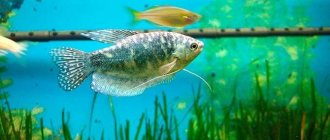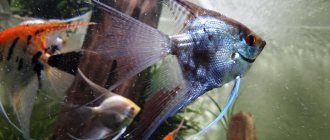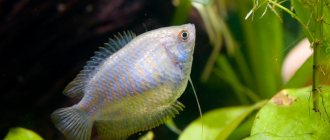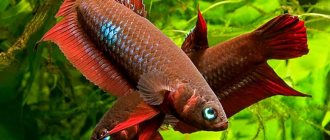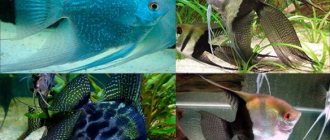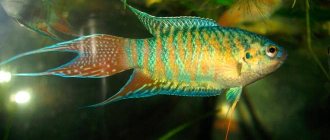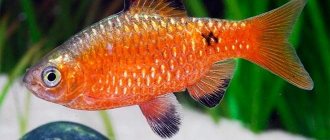Gourami gender: determined by external signs
String gouramis belong to the genus of labyrinth fish, and four main species are bred in aquariums:
- pearl;
- spotted;
- blue;
- marble.
Moreover, in any species, the difference between a female and a male is noticeable to the naked eye.
Firstly, size. In nature, threadworms grow up to 15 cm, but domesticated species rarely grow more than 10 cm in length. The female is smaller than the male and not as slender as him . Girls are more “knocked down” and strong.
The male gourami is larger and has a brighter color.
Secondly, color. The male and female of the same species have a significant difference in this parameter. And here again the male wins: he is brighter and more elegant. This becomes especially obvious before spawning, when pigmentation intensifies. For example, in spotted fishtails the spots on the dorsal fin become brighter, and in pearlfish, the chest and front part of the abdomen become covered with a reddish-orange “blush”.
Thirdly, the dorsal fin. To understand whether the fish in front of you is a boy or a girl, carefully examine this part of the fish’s body. A long and large fin indicates a male, and a shorter and rounded fin indicates a female. It is the shape and size of the dorsal fin that is the most reliable sexual characteristic.
The anal fin is also different in fish: shorter and rounder in a girl, longer and more pointed in a boy.
Reproduction
Puberty occurs at 8 months. When there are 12 days before the expected spawning, it is necessary to separate the male and female from each other in separate containers. At this time it is better to feed bloodworms and cyclops. The protein content should be increased. When the water temperature is 29 - 30 °C, reproduction can begin.
Remember the main rule, based on which you can almost always distinguish a female gourami from a male gourami. The latter are always brighter in color and larger.
To do this, the male is placed in a container of about 40 liters, where there is a lot of shelter and stones. To build a nest, it needs floating, large plants in the container. The light is dim. Aeration must be turned off, otherwise it will damage the nest. After 7 hours, a female is placed next to the male. Seeing her, the color of the male will become even brighter. Then he will begin to build a nest, and the female will watch him at this time, but will not take part in the construction. The process will take 2 days.
01:29
Male marbled gourami builds a nest of air bubbles
13:22
Gourami spends a day in the spawning tank
When everything is ready, the male attracts the female, carefully squeezes the eggs out of her and at the same time fertilizes her.
The eggs then develop in about 3 days. During this time, it is especially important to maintain the same temperature. It should be around 29 °C. When the fry appear, the male is placed separately so that he does not destroy his own offspring. The fry are kept in the spawning tank for another 2 months. They provide live food as food. The temperature is reduced after 1 month.
Caring for and breeding pearl gourami is not particularly difficult. The main thing to remember is good nutrition and proper maintenance in the aquarium. Then this little fish will delight you for a long time.
Gourami's behavior also reveals their gender
Did you know that you can determine the gender of a gourami simply by observing how these fish behave in an aquarium?
Sexual differences in gourami.
Male threadtails are territorial fish, they protect the borders of their possessions and can forget about their friendliness if a potential rival invades. Therefore, if your aquarium cannot boast of spaciousness, then you cannot place more than one male in it . But for a large aquarium this rule is irrelevant: the males will divide the territory among themselves and will be able to coexist very peacefully.
Have you noticed that gouramis chase each other? Now take a closer look at who is “running away” and who is “catching up.” This usually happens before spawning: the male chases the female gourami, but this is a kind of courtship dance. In this case, no aggression should be observed. Confirmation of mating games is the color of the male, which becomes more intense and brighter. At the same time, from time to time the “suitor” will swim to the surface of the water and release a stream of bubbles. This is a sure sign that it’s time for the couple to leave for spawning.
Gourami mating dance.
However, the male may not be so gallant if the female has already shed her eggs. He can drive away the female not only during the construction of the nest, but even if the eggs were eaten by other fish (this very often happens if the female is not placed in a separate aquarium for spawning) - this is how natural instinct works.
True, males can also chase each other, as a rule, without dividing the territory or the “lady of the heart.” In this case, it is the filamentous pelvic fins that are often affected in filament bearers. However, these fins regenerate quickly.
Breeding
Spawning in pairs; to obtain a full litter, a large number of floating plants are placed in a spawning tank of 20-40 liters with well-settled water, and several shelters are equipped in it for the female.
Before spawning, the male and female are kept separately for a week and feed on tubifex and bloodworms.
The temperature in the spawning tank is 28°C, pH 7, dH 4-8.
Spawning is stimulated by adding a third of distilled water. The male is first introduced into the spawning aquarium, and after a few hours the female is introduced. The male builds a nest from pieces of plants and air bubbles.
Then he brings the female to the nest and spawning begins. The male carefully places the floating eggs in the nest. These fish are low-fertile, no more than 300 eggs. Then the female settles down.
The incubation period depends on temperature and lasts 24-48 hours. After another 4-5 days, the fry swim, after which the male must also be removed.
The water level drops to 10 cm until the labyrinth organ is formed in the fry. Light aeration can be installed, especially if there are a lot of fry. At the initial stage, live dust is accepted - ciliates and rotifers; after a few days, larger food is allowed - artemia nauplii and microworms.
The growth of fry is rapid, but uneven, so large ones must be removed to avoid cases of cannibalism.
It is a fairly long-lived species and can live in an aquarium for 8 years or more.
Why is it important to be able to distinguish the sexes of gourami?
- Placing two male gourami in a small aquarium means dooming them to involuntary competition. Therefore, the ideal option is a pair of fish of different sexes.
- Without knowing how to distinguish a female from a male, you may miss spawning time. Or you can accidentally plant a couple of males for spawning and wait for offspring without success. And all because many people mistake a well-fed fat male for a female with eggs.
- By choosing the right gourami, you will ensure their reproduction, and these fish, believe me, are worth spending your time caring for them and their offspring. Gourami - graceful and peaceful inhabitants of the aquarium, diversify the life of a small underwater world and will cheer you up every day.
Varieties of aquarium gourami fish
Pearl gourami.
The color of the fish is silver with a pearl tint. During spawning, the purple color begins to predominate. The body is laterally compressed, oval in shape. The dorsal and anal fins are large.
Moon gourami.
Body color is silver with a blue tint. The filamentous fins are orange-red. In natural conditions, the fish reach a size of 18 cm, in an aquarium no more than 12 cm.
Serpentine gourami.
This is the largest species of gourami. It grows up to 25 cm, in aquariums up to 15 cm. The body is elongated, the back part is slightly curved upward. The body color is mainly brownish-green, with a dark horizontal line on the sides.
Spotted gourami.
The color of the gourami is silver with a purple tint, with purple stripes across the body. The fins and tail are transparent with pale orange spots. In nature it can grow up to 20 cm, in aquariums up to 12 cm.
Marbled gourami
Characteristics of the fish
Aquarium pearl gourami has an oval, slightly elongated body shape, with males being slightly larger than females.
- Body size is up to 11 cm in captivity. In natural habitat – up to 15 cm;
- The body color is silver with a pink tint, studded with pearl dots. There is a black stripe in the middle of the body;
- Life expectancy is up to 7 years with proper care.
You can also distinguish a male from a female by the following characteristics:
- The boy has a brighter, more intense coloring;
- It also has a slightly longer dorsal fin, which gives the impression that it is sharper;
- But the most distinctive characteristic appears during the mating season - the male begins to literally shine with every pearl on the body, shimmering with mother-of-pearl, and the abdomen and chest become bright red. This is how he attracts females.
Female and male gourami
They have fins growing on their abdomen, more like long threads, in the photo above. They have a tactile function; they are used by fish to probe the bottom in the turbid waters in which they live in natural conditions.
Aquarium for gourami
To properly keep fish in an aquarium, the following conditions must be met:
- Water volume – at least 40 liters;
- pH – from 6 to 7;
- temperature - from 23 to 27 degrees.
Be sure to install a filter and local lighting from a 40-watt incandescent lamp.
Aquarium with gourami
It will be a little difficult to equip the aquarium with a variety of living plants; this is a mandatory requirement. Use elodea and vallisneria, and plant duckweed on the surface of the water. Only in such conditions will gourami feel comfortable and safe, and stress is destructive for them.
The aquarium can also be shared with other fish; they have good compatibility, but are not aggressive like swordtails or barbs. It is also not recommended to introduce too small fish or fry into their aquarium; gouramis can eat them.


